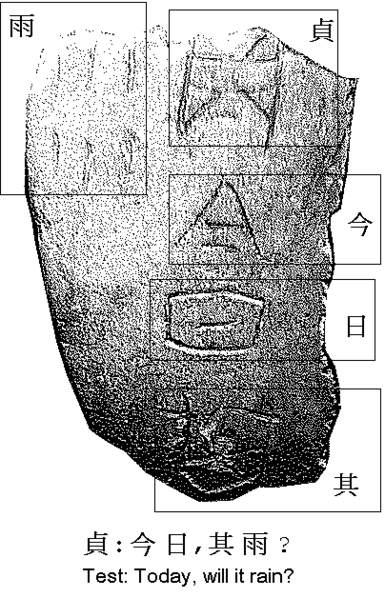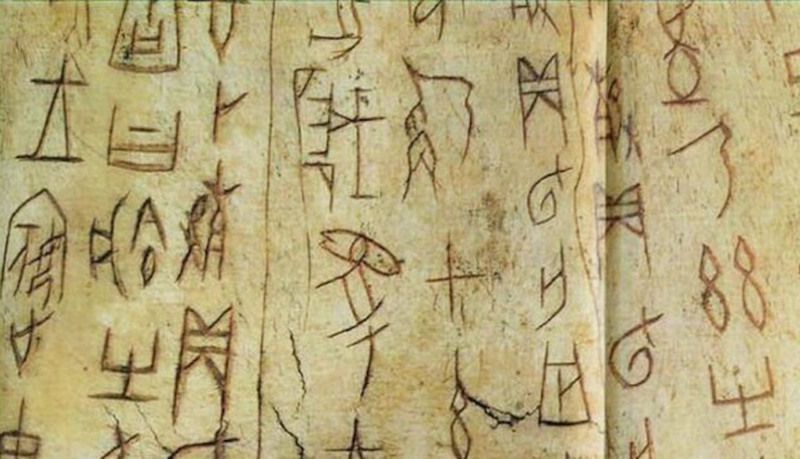For Lecture 2, what piqued my interest the most was the slide on Oracle Bone Scripts. Desmond told us that in Ancient China, writing was inscribed upon animal bones and turtle shells. These scripts were then pushed through with a hot rod, so that the cracks on the bones could be read and analysed for divinations.
I found the Oracle Bone scripts really interesting for 3 main reasons:
- The very medium of the script
- The forms of the inscriptions
- The function of the Oracle Bone script
- Using animal bones, especially ox scapulaes and turtle plastrons, as a medium is such a weird choice. I really wonder who came up with that. It seems really resourceful of them; but at the same time, a rather dark thought to be using dead animal bones/shells/skulls and engraving writing on it.
Oracle bone script, 甲骨文, is unequivocally the oldest recognizable Chinese inscription. It is estimated that Oracle Bone scripts were used between 1800-1100 BC, around (and possibly before) the Shang Dynasty period. I find it intriguing that during this period, writing on hard animal bones was so common in China, whilst other places in the world were already using softer (and I would assume, easier to inscribe) materials- For example, Desmond was going through the use of papyrus, parchment and vellum in the previous slides. The earliest use of Papyrus is said to be in Egypt during 3000BC and about 2550-2450 BC for parchment. This difference in hard/soft materials highlights how knowledge was not easily transmittable and shareable in the old days.
Oracle Bone script on a turtle shell: 
- It is said that among all the Oracle Bone scripts that have been found, the text contains over 30,000 distinct characters, many of which are thought to be variant forms of about 4,000 individual characters. However, out of all these characters, many remain undecipherable by scholars till this day. Can you imagine all the words that have been lost in the translation of time?
Additionally, its really cool how the writings on the Oracle Bone scripts paved the way for the modern Chinese writing we are so familiar with today. Oracle Bone characters have a pictorial nature, suggesting that they have pictograph origins. However, the characters used in the script are not solely pictographic in function. Instead, they were part of a writing system that was fully functional and mature by the era of the Shang dynasty. Many of the characters were not realistically depicted enough for people who had no prior knowledge to be able to comprehend the script. Each character had gone through stabilization/abstraction/simplification to functionally represent words, and by extension, concepts. (They were termed as zodiographs by William G. Boltz and Semantographs by Qiu Xigui). Gradually, these characters further evolved to its predecessors- mentioned in the following slides, such as Bronze Ware Script and Seal Script, till our modern day Chinese text.
Some examples of Oracle Bone characters (and its modern counterpart):

- Lastly, the purpose of the Oracle Bone scripts is just as fascinating to me. They were used for pyromantic divination, a process which involved inscribing a question with a bronze pin, then heating the bones and inspecting any resulting cracks for the divine answers to one’s questions. These questions mainly centered upon warfare, weather, hunting, and the selection of auspicious days for ceremonies. Again, the question of who even thought of this, lingers in my mind. How do you interpret each and every crack, in relation to the question? How do you learn to do so when every single Oracle Bone Script is very different due to the different bone used, question asked, resultant crack, et cetera? I think trying to read the divination results is an art itself haha. This whole ritual and belief around the Oracle Bone script really shows how auspicious and spiritual the society and its culture was back then.
Example of an annotated script:


